January 12, 2007
Air Date: January 12, 2007
FULL SHOW
SEGMENTS
Short Changing Science
View the page for this story
Despite President Bush’s call last year for an increase in funding for science research, Congress failed to pass a number of federal spending measures, including allocating more money for basic research. Kei Koizumi of the American Association for the Advancement of Science says this will put a financial crunch on thousands of scientists across the country, as well as on big agencies. (06:00)
Nick-ing Big Oil’s Bucks
View the page for this story
Democratic leaders in Congress pledge to repeal subsidies to the oil industry. Living on Earth's Jeff Young talks with the new chair of the House Natural Resources Committee, Nick Rahall of West Virginia, who thinks the money now going to the oil industry should instead go toward turning coal into transportation fuel. (06:00)
Motor Show Visits Motor City
View the page for this story
Automakers at this year's North American International Auto Show in Detroit unveil a series of promising new green technologies...but are any of them ready for the market? Living on Earth host Bruce Gellerman talks with IEEE Spectrum’s car expert John Voelcker from the showroom floor. (07:00)
Hybrids on the High Road
View the page for this story
A new study by Intellichoice.com, an L.A. based auto-buyers guide, compares the cost of hybrid cars to conventional cars and reveals that over a five year period, hybrids cost thousands of dollars less than similar-sized gas engine vehicles. Host Bruce Gellerman talks with James Bell, publisher of the study, about his results. (03:00)
All Aboard!
/ Ashley AhearnView the page for this story
Buying a hybrid car might save you some money, but if you really want to pinch pennies, the best idea is to use public transportation. Living on Earth’s Ashley Ahearn reports. (01:30)
Navajos Camp Out Against Coal
/ Eric MackView the page for this story
In the second installment of the series “Generating Controversy: The Changing Climate of Coal” reporter Eric Mack visits a Navajo reservation in New Mexico. The Navajo have lived with coalmines and coal plants for generations; now investors want to build a new plant on the reservation. The tribal council approved the plant proposal but some older Navajos are saying “no.” (06:00)
Miss R.I. Heats Up Competition
View the page for this story
The Miss America pageant is an enduring icon of American culture. This year, Miss Rhode Island, Allison Rogers, hopes to heat things up at the competition by wearing a bikini, playing Chopin, and giving a platform statement on global warming. She talks with host Bruce Gellerman. (06:30)
The Future of Robotics
View the page for this story
From vacuum cleaners and lawnmowers to military landmine detectors, robots are becoming increasingly present in our daily lives. Living on Earth’s Bruce Gellerman visits MIT’s Computer Science and Artificial Intelligence Laboratory (CSAIL) to meet a humanoid robot named Domo, its creator, PhD student Aaron Elsinger, and the man behind all the magic, CSAIL director Rodney Brooks. (10:30)
Show Credits and Funders
Show Transcript
HOST: Bruce Gellerman
GUESTS: James Bell, Rodney Brooks, Aaron Edsinger, Kei Koizumi, Alison Rogers, John Voelcker
REPORTERS: Ashley Ahearn, Eric Mack, Jeff Young
[THEME]
GELLERMAN: From Public Radio International-this is Living on Earth, I’m Bruce Gellerman.
[THEME]
GELLERMAN: I’m Bruce Gellerman. The failure of the last Congress to pass nine out of eleven federal spending bills will hit U.S. scientists right where it hurts.
KOIZUMI: It’s becoming a lot more difficult to win research grants. We have scientists who used to have about one in three odds of getting research grants now facing one in five and sometimes ten percent odds in getting research grants.
GELLERMAN: Also, a powerful Congressional Democrat wants to slash subsidies to big oil.
RAHALL: There’s no question, and I think its agreed in a bipartisan fashion that the present oil and gas royalty collection system is broke. And it needs repair.
GELLERMAN: And in New Mexico, the Navajo Council approves a new coal power plant but tribal elders say no and put their bodies on the line.
WILLIE: I can stay here all for winter until everything is straightened up until they completely stop.
GELLERMAN: Coal generating controversy this week on Living on Earth. Stick around!
[NPR NEWSCAST]
ANNOUNCER: Support for Living on Earth comes from the National Science Foundation and Stonyfield Farm.
[THEME]
Short Changing Science
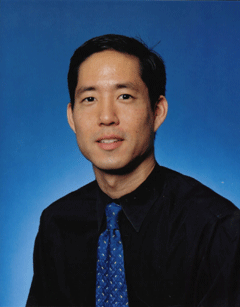
Kei Koizumi is the R&D Budget and Policy Program Director American Association for the Advancement of Science. (Courtesy of AAAS)
GELLERMAN: From the Jennifer and Ted Stanley Studios in Somerville, Massachusetts - this is Living on Earth. I’m Bruce Gellerman. Just about a year ago, President Bush announced what he called the “American Competitiveness Initiative,” asking Congress to add billions of additional dollars to fund basic science research.
[APPLAUSE]
BUSH: And to keep America competitive one commitment is necessary above all. We must continue to lead the world in human talent and creativity. Our greatest advantage in the world has always been our educated, hard working, ambitious people and we’re going to keep that edge. Tonight I announce an American Competitiveness to encourage innovation throughout our economy, and to give our nation’s children a firm grounding in math and science. First, I propose to double the federal commitment to the most critical basic research programs in the physical sciences over the next ten years. This funding will support the work of America’s most creative minds as they explore promising areas such as nanotechnology, super computing, and alternative energy sources.
GELLERMAN: That’s not quite the way it turned out. For the first time in at least thirty years, the federal government will invest less money in basic science research this year than it did in the last. That’s because Congress passed only two out of eleven federal spending bills last year. So departments will get this year what they got last year and when adjusted for inflation, that means less. Kei Koizumi is the chief budget analyst for the American Association for the Advancement of Science. It’s the world’s largest science organization.
So Mr. Koizumi, what happened?
KOIZUMI: Well, the last Congress ran out of time. They decided to get out of Washington early before the November elections in the hope, of course, of preserving the Republican majority when that didn’t happen they came back in November. But instead of trying to finish up its business they decided to punt it to the next Congress. So that was a decision they made and I suppose I can understand why they did it but it did represent a failure to do the one thing that Congress has to do each year, which is to pass the federal budget.

Kei Koizumi is the R&D Budget and Policy Program Director American Association for the Advancement of Science (Courtesy of AAAS)
KOIZUMI: Well, mostly thousands of individual scientists around the country who apply for federal research grants. It’s becoming a lot more difficult to win research grants. We have scientists who used to have about one in three odds of getting a research grant now face one in five and sometimes 10 percent odds in getting research grants.
GELLERMAN: So which parts of government? Which departments? Which agencies?
KOIZUMI: The agencies that are feeling it the most strongly are the National Science Foundation and the Department of Energy. The National Science Foundation was singled out by President Bush as one of the priority agencies to get more research funding. And it’s because for most disciplines NSF is the primary sponsor of university research. Also the Department of Energy office of science because it’s a heavy supporter of the physical sciences, which are an important part of his American Competitiveness Initiative. So, these two agencies were hoping for a lot of new money to be able to fund new research projects but instead they’re having to deal with a dramatic scale down in their plans.
GELLERMAN: What about the National Institutes of Health?
KOIZUMI: Now NIH had some very good budget years. Between 1998 and 2003 Congress doubled the NIH budget. But since that time NIH funding has been flat. So NIH, although that situation is very difficult, at least has had some time to get used to this new budget reality of not being able to fund all the biomedical research that it would like to.
GELLERMAN: What about research for the Department of Defense? They got their appropriation passed.
KOIZUMI: That’s actually one of the good signs coming out of the last Congress that the DOD did get its final budget so Department of Defense’s support for disciplines like mathematics, computer science, and engineering is moving forward and at a slightly increasing rate. So, we’re optimistic that DOD can make some of the investments in long term science that could pay off eventually in both the civilian economy and of course, the military.
GELLERMAN: What about China’s investment in R&D?
KOIZUMI: Well, when we look abroad we see that China and other Asian nations are getting this link between investments in research and future economic growth. And so the Chinese government, for example, is increasing its R&D investments by 10, 15, 20 percent a year. But now we’re finding that many Asian scientists and engineers are going back to their home countries because the research opportunities are there. And that’s all well and good. But as a nation I think we have to think a little bit carefully about what kinds of research and how much basic scientific research we want happening here in the United States.
GELLERMAN: This seems bad for science funding in the short term, but how did federal agencies like NIH and the National Science Foundation weather federal cuts like this in the past?
KOIZUMI: Well, most federal agencies know that when it comes to budgets there are ups and there are downs. So it’s a matter of survival and most federal agencies will get through this. The question of course is what are the opportunities that are lost or delayed when funding is a stop and start process. Now, maybe we can afford to delay funding basic physical sciences funding for a year or two. But clearly we seem to recognize as a nation that when it comes to our future US economy it’s time to move forward and to make the investments now so that a couple years from now we will have the knowledge necessary to compete in the world economy. And maybe that’s not something that we can afford to delay.
GELLERMAN: Kei Koizumi is director of R&D budget and policy program at the American Association for the Advancement of Science. Mr. Koizumi thank you very much.
KOIZUMI: Thank you.
Related links:
- American Advancement for the Association of Science
- American Competitive Initiative from President's State of the Union 2006
Nick-ing Big Oil’s Bucks
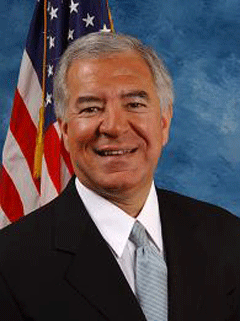
Congressman Nick Rahall (Courtesy of U.S. House of Representatives)
GELLERMAN: The Democrats who just took control of Congress are promising a new direction on energy and the environment. One of the key players who will set the new course is Representative Nick Rahall of West Virginia. Rahall heads up the House Committee on Natural Resources. Among other things, the committee oversees federal programs on endangered species, national parks, and public lands. But the issue likely to get the most attention from the committee is the extraction of oil, gas, and minerals from federally-owned property. It puts Congressman Nick Rahall’s newfound power up against the powerful forces in the U.S. energy industry.
Living on Earth’s Jeff Young reports.
YOUNG: For more than three decades Nick Rahall has represented the third district of West Virginia--the rural, economically struggling counties that form the heart of Appalachia’s coal country. Now that he chairs the powerful House Committee on resources Rahall hopes to put coal to broader use. He wants money currently going to the oil industry to instead support technology that turns coal into a liquid transportation fuel, similar to diesel.
RAHALL: There’s a lot of coal in West Virginia there’s a lot of coal in eastern United States there’s a lot of coal in this country enough to supply us at a minimum for 250 years into the future and at a more economical price than what we’re paying for a barrel of oil. Yes, we should continue using coal to free this country from reliance upon foreign oil; yes, coal is a friend to our people.
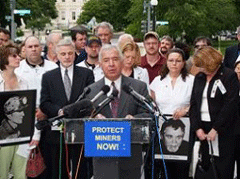
Congressman Rahall speaking at a rally for mine safety legislation. (Courtesy of U.S. House of Representatives)
RAHALL: I do not advocate throwing the baby out with the bath water. Because the program itself has worked over the years and the basic framework is sound.
YOUNG: Rahall’s first act as chair was to add the word Natural to the committee’s name--a reminder, he says, of its broad responsibilities for stewardship. It oversees the Department of the Interior, which manages parks and public lands across the country and waters off the coast. Rahall says the committee under Republican control had largely abdicated its oversight role, and he hopes to restore that with hearings on how the Interior department manages royalties for oil and gas drilling on public land.
RAHALL: To strongly ask questions that perhaps have not been asked of this administration for the last six years, serious and tough questions: Why haven’t we collected for American taxpayer what is due the American taxpayer?"
YOUNG: Drilling royalties are the payments oil and gas companies make to use public land and waters. The Interior Department’s Minerals Management Service makes lease contracts with the companies. And it’s come under withering criticism in the past year for letting perhaps billions of dollars in royalties go uncollected. Back in the mid 90s, when the price of oil was low, a law called the Royalty Relief Act encouraged deep water exploration with a break from some royalties. Some lease contracts offered that break only when prices were low. Rahall says there was mismanagement of the royalty collections when oil prices soared.
RAHALL: There’s no question, and I think it’s agreed in a bipartisan fashion, that the present oil and gas royalty collection system is broke. And it needs repair. There are members of both sides of the aisle that agree that there are billions of dollars that have not been collected.
YOUNG: Officials at the Interior Department declined to comment. The department recently raised royalty rates slightly, and officials have tried to persuade oil companies to renegotiate leases for drilling rights in the Gulf of Mexico. Minerals Management chief Stephen Allred announced agreements with five companies last month.
ALLRED: These are the companies who have stepped up who have worked with us to find a solution to this, I hope it’s the first of many who will do this.
YOUNG: But more than fifty companies including some of the biggest in Gulf drilling—Exxon-Mobil and Chevron--said no thanks. John Felmy is chief economist for the American Petroleum Institute, the oil industry’s trade group in Washington. Felmy says a contract is a contract.
FELMY: To now go back and start revisiting these things is really a violation of fundamental contract principles of the United States. The royalty relief act is probably one of the most successful energy programs ever put in place. We’ve been able to find a vast amount of oil, we’ve been able to bring supplies to consumers. And we would hope that Congress understands that, and let’s not change what has been a success.
YOUNG: The incentives of the royalty relief act went into effect when oil was around 15 dollars a barrel. Now it fetches more than fifty—and that means royalty relief will get little sympathy in the hearings before Rahall’s committee.
RAHALL: I think with prices what they are today, with record profits being made by the oil companies today--more profits of any company in the history of our country—I hardly think now is the time that they need more incentives, and more grants, and more royalty holidays to go out there and drill.
YOUNG: Democratic leaders are going after oil subsidies in their first hundred hours of legislative action. Thursday, the House will debate a bill penalizing companies that refuse to renegotiate drilling contracts. And the bill would redirect oil subsidies to alternative fuels. For Living on Earth I’m Jeff Young in Washington.
Related links:
- House Committee on Natural Resources
- Interior Department’s Minerals Management Service
- Congressman Nick Rahall
[MUSIC: Brian Eno “Kurt’s Rejoinder” from ‘Before And After Science’ (Virgin - 1979)]
GELLERMAN: Coming up not too far down the road, GM hopes you’ll see the USA in your electric Chevrolet. Keep listening to Living on Earth.
[MUSIC: Medeski, Martin & Wood “Hanuman” from ‘Out Louder’ (Indirecto – 2006)]
Motor Show Visits Motor City
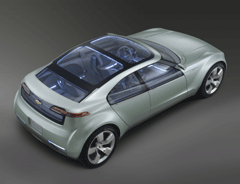
Chevrolet’s Volt (Courtesy of GM)
GELLERMAN: It’s Living on Earth. I’m Bruce Gellerman.
[MUSIC: David Grisman “Dawgy Mountain Breakdown (aka – NPR’s ‘Car Talk’ Theme)” from ‘Dawg Grass/Dawg Jazz’ (Warner Bros. – 1983)]
GELLERMAN: With apologies to those two knuckleheads, Tom and Ray, it’s now time for a little car talk. Toyota is poised to become the world’s largest maker of vehicles, leaving GM in the dust. Part of the reason for the Japanese car maker’s success is it’s domination of the hybrid market which has other car makers green with envy. But the race for fuel-efficient autos is far from over. Joining us from Motor City, home to the North American International Auto Show, is John Voelcker. He’s a correspondent with IEEE Spectrum and our man on the floor of the show.
GELLERMAN: Hi John.
VOELCKER: Hey Bruce.
GELLERMAN: Hey, I understand that this is the 100th anniversary of the Detroit Car Show.
VOELCKER: That’s right. Exactly 100 years ago in a beer garden in Detroit Henry Ford announced the Model T, which kicked off really the automotive century. So this is a very important show not only for Detroit, but for the automotive industry globally.
GELLERMAN: But why is it so important?
VOELCKER: There are only a handful of really global automotive shows: one in Tokyo, one in Frankfort, Germany. This is North America’s show where the entire industry comes together to show off its best concepts, its newest production vehicles.
GELLERMAN: What environmental themes have come out of this show so far?
VOELCKER: Several environmental themes. Of course, the biggest one is fuel economy or more broadly reducing reliance on petroleum. But more than that the emergence of some truly significant new technologies, in concept form, that will probably change the cars we drive in the next 5 to 20 years enormously.
GELLERMAN: What’s new in hybrid cars?
VOELCKER: A lot of hybrid developments. One GM has already launched and you’ll see them on the road this year, what they call their two mode hybrid. This is a hybrid for big vehicles. If you think about Priuses and Civics and things like that, they’re smaller cars. GM is putting its hybrid in its biggest, heaviest SUVs. And there, they say you’ll get 25 percent better mileage. These are things like Chevy Tahoe that can way up to three tons. So that’s a fairly major advance in hybrids. But probably the most significant car here and certainly the star of the show with the public and with the press is the Chevrolet Volt. Which is a plug-in hybrid, but totally different from any kind of hybrid we know of today.

Chevrolet’s Volt (Courtesy of GM)
VOELCKER: Today’s hybrids run on gasoline supplemented by electric power driven by batteries, ok? So you’re running most of the time on gas and occasionally the electric motor boosts the gas or you can run on electricity at low speeds for a very short time- a couple of minutes. The Chevrolet Volt is an electric car where it can run up to 40 miles on a lithium ion battery pack, same kind of batteries as in your cell phone. And it’s got an engine on board, but only to charge the batteries. That engine doesn’t drive the car. And the assumption is that you’ll use this car mostly in pure electric mode; no noise, no gasoline.
GELLERMAN: But John, who drives 40 miles a day?
VOELCKER: Well, 80 percent of Americans as it turns out commute a total of 40 miles or less to work and back. So, if you’re just using this car to get to work and back you might never use any gasoline. You might have infinity gas mileage.
GELLERMAN: I’m wondering weather it’s gas price or whether it’s environmental aspects that are driving the interest in these kinds of green cars. I mean if the price of gas came down you’d think people would be revolting, that is kind of doing away with the hybrids and electric cars?
VOELCKER: I think that’s a good point. I don’t think you can really separate out gas prices and environmental considerations. But it’s pretty clear over the last 30 years we’ve had what three, four fuel price shocks? The Detroit makers get the message. And more than that the more global the industry gets they see the rest of the world has really good small and medium sized cars in American terms. Small cars frankly were an afterthought for a long time for American makers, and that’s not going to be the case any longer. But it’s not to say that the Japanese are going to role over and play dead, or the Koreans, or for that matter there was a Chinese maker that exhibited here.
GELLERMAN: We’ve all heard about how the Chinese car market is growing by leaps and bounds, but China doesn’t have a large infrastructure of gas stations yet. Could they be leap frogging? That is, instead of building gas stations go right to fuel cell stations, electric power stations?
VOELCKER: That’s an excellent question and it’s very much a topic of consideration here. If you talk to some of the executives, off the record, you get the feeling that in fact China may go directly to a hydrogen economy. Um, because as you pointed out they don’t have the network of filling stations and if you’re going to build filling stations you don’t just have to put gasoline pumps in you can put other kinds of pumps in, or you can build them around other kinds of fuels to start with. It’s not clear yet, and as China’s auto market grows by leaps and bounds they’re going to have to figure that out pretty quickly. I think everybody is going to wait to see what happens. This is a case where the Chinese government still has an enormous amount of sway in deciding that and in some ways deciding China’s energy foot print for a while to come as the Chinese buy cars to bring themselves to the penetration of car ownership that the rest of the world has.
GELLERMAN: John, I want you to look down the road a bit at next year’s auto show, early 2008. What do you think we’re going to be talking about then?
VOELCKER: Well, one of the things is you see concepts every year. And one of the wraps against a number of automakers has been you show us great stuff, cool technology, but we never see it in production. It’s never at the dealer. So one of the things to look for next year is you have a number of exciting technologies have there been commitments to produce them? Have there been dates? Are we seeing a radical show car like the Volt translated into a production vehicle that they can test? In other words, great concepts- show us the meat. Show us when it’s coming. Tell us when we can buy it.
GELLERMAN: Hey John, thank you very much.
VOELCKER: My pleasure. Thank you Bruce.
GELLERMAN: John Voelcker is a big wheel, and a correspondent with i-triple e Spectrum.
Related links:
- North American International Auto Show, Detroit
- Wired blog on the Chevy Volt
- Chinese Made Cars
Hybrids on the High Road
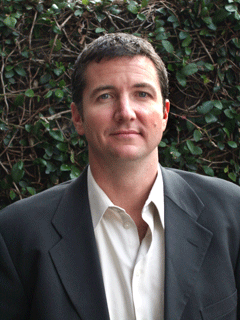
James Bell is publisher of Intellichoice.com.(Courtesy of Intellichoice.com)
GELLERMAN: Conventional wisdom has it that hybrid cars save on gas but they’re a lot more expensive to buy, and in the long run, more expensive to own. But a new study by an L.A. based auto buyer’s guide calculated the total cost of owning a hybrid over five years, and found well, let’s ask James Bell. He’s publisher of Intellichoice.com and he joins us from the Detroit Auto Show. James, you did the study. So let’s compare the cost of similar midsize cars—say, the hybrid Toyota Prius with a regular gas engine Camry. Show me the money.
BELL: Oh, yes. According to our cost of ownership analysis you’re looking at a 13,000 dollar savings.

James Bell is publisher of Intellichoice.com. (Courtesy of Intellichoice.com)
BELL: Well, if you look at how the vehicles going to depreciate, what it’s going to cost you to maintain and of course the fuel savings, it all adds up.
GELLERMAN: But with a hybrid don’t you need to buy those batteries and aren’t they very expensive?
BELL: Ah, I’m so glad you brought that up. That has been a real misconception of hybrids and the battery packs that are within them. I personally bought a 2004 Prius, and myself, I was a little bit concerned about the batteries; there’s enough kind of water cooler talk about it. Well, now since I’m working in the industry I’ve now been privy to some other information and I know that there have been independent studies done bench testing those battery packs. And they’ve lasted in excess of 250,000 miles before anything needs to be done to them.
And the primary reason for that, I believe, is that you’ve got people with cell phones, and digital cameras, and camcorders with rechargeable batteries and we charge them all the way to the top and then let them drain all the way to the bottom and then do that over and over again. Well, that’s brutal. That’s very difficult on the battery life itself. What a hybrid vehicle does is it uses the computers to make sure that the battery is no more than 70 percent full and no less than 30 percent emptied. So you’ve always got it in that sweet spot and battery life has fully exceeded any expectations. Even if you look at the first generation Prius, it just has not been an issue what so ever.
GELLERMAN: If owning a hybrid is in fact less expensive than owning a regular car what will that mean for the future of the hybrid model?
BELL: Well, I think this sort of information is going to be getting out to more and more people and they’ll realize that hybrids should be on their shopping list for reasons other than purely fuel economy or purely environmental reasons. I mean no vehicle is a good investment. Maybe only a Ferrari is going to give you a return. And since this is the second largest purchase you’re going to make you better do it as smart as possible. So, we found that among all the vehicles out there that hybrid is the best alternative. You’re not necessarily going to make money, but you’re going to lose definitely the least.
GELLERMAN: James Bell is publisher of intellichoice.com, an online auto buyers guide. Hey, James, thank you very much.
BELL: It’s been a pleasure. Thank you very much.
Related links:
- Intellichoice
- “Hybrid autos save money in long run, study finds” in The Los Angeles Times
All Aboard!
GELLERMAN: If you really want to save money and the environment, consider leaving the hybrid in the driveway altogether. A new study has some startling figures on just how much we’d save by taking public transportation. Here’s Living on Earth’s Ashley Ahearn.
AHEARN: The study was conducted by the consulting firm ICF International for the American Public Transportation Association. APTA’s William Millar says that even using conservative estimates, public transit use already saves the U.S. almost a billion and a half gallons of gas a year.
MILLAR: Well, that’s equal to about 90 percent of all the oil that we import every year from Kuwait, for example. It’s 18 times more than the oil we save by bio-diesel that we might use. Beyond that, it’s pretty clear that households that live near public transit save a lot of money. In fact, an average household where at least one worker uses public transit can save over $6,200 per year.
AHEARN: The study says that’s more than the average household spends on food. But Millar says the benefits of trains and buses to both families and the country are being lost amid all the talk about higher mileage cars and alternative fuels.
MILLAR: In the last federal energy bill there was virtually no mention of public transit. Now to solve our addiction to foreign oil we’re going to need to do many things. What we want to say is public transit needs to be part of that mix.
[SOUND OF CAPITOL HALL WAY]
AHEARN: Millar wants Congress to invest more in mass transit. But he says there are other ways to get more people on public transportation, like tinkering with the tax code. For example, he says, under current tax law an employer gets a bigger deduction by offering free parking for workers than she would by helping employees pay their subway or bus fare.
For Living On Earth, I’m Ashley Ahearn.
Related links:
- “Public Transportation and Petroleum Savings in the U.S.: Reducing Our Dependence on Oil” prepared for the American Public Transportation System
- American Public Transportation Association
[MUSIC: Thomas Wydler & Toby Dammit “The Great Lie” from ‘Morphosa Harmonia’ (Hit Thing - 2004)]
Navajos Camp Out Against Coal

San Juan Power Plant, Four Corners, New Mexico. (Photo: © Carlan Tapp)
GELLERMAN: We now continue with our occasional series that we call “Generating Controversy: The Changing Climate of Coal.” The construction of new power plants that are fueled by coal is meeting stiff resistance in many parts of the United States. But perhaps nowhere is the clash as dramatic as on the Navajo reservation in New Mexico. The Northwestern part of the state already has two coal-fired power plants. And now, there are plans to build a third in the area. This one would be much cleaner than the others but a group of Navajo elders want to stop it before it gets off the drawing board.
Eric Mack reports.
MACK: Just south of Farmington, New Mexico, a road climbs to the top of a rocky hill covered with radio, TV, and cell towers. From up here, you can watch the sunset cast hues of pink and orange across the arid basin below. But a little to the north, those bright colors mix with a brown haze that hangs over Farmington and the Highway into the Navajo Reservation.
In the foreground I can see two big plumes of smoke and steam. They’re coming from the San Juan and Four Corners coal power plants. And with a quarter turn to the left I’m looking at the site of the new 1500-megawatt Desert Rock energy project.

San Juan Power Plant, Four Corners, New Mexico. (Photo: © Carlan Tapp)
[DRIVING AND DOOR OPENING]
MACK: Down below, along a rough road, is the entrance to the site, guarded by Navajo police. They've been here since December.
That's when a group of Navajo elders, local residents and their supporters blocked the entrance and set up a camp. Navajo police later moved the protesters’ camp to the other side of the road, and that’s where they’ve been camping ever since, through one of the coldest New Mexico winters in recent memory.
Elouise Brown is the president of Do’oda or “No” Desert Rock, a committee that opposes the new plant…
BROWN: We’re camping here and our reason is that we don’t want the, the third power plant here within a 25-mile radius and the reasons why we don’t want the power plant is because we want to be you know, keep our health, keep our land, keep our air fresh and we want to keep our water.
[CHOPPING WOOD]
MACK: In the last month, the camp has grown to a cluster of tee-pees and campers around a makeshift kitchen and fire circle. Today the grandchildren are pitching in to help cut up a load of firewood dropped off by volunteers.
Lucy Willie lives just a few miles from the site. And for the past month, she’s been spending most of her time here at the camp, holding vigil over the area, which she says is filled with sacred sites. She says coal has already taken enough of a toll here, and to illustrate the point, she motions across the empty grassland to a tall mound of coal waste or tailings.

Lucille Willie says, "The air is polluted, it is hard to breathe. The sheep have a hard time finding fresh plants to eat. It is not the right thing to do to restructure Mother Earth. “ The two lambs in Lucille’s arms died the following week.
(Photo: © Carlan Tapp)
MACK: You talking about this mine over here?
WILLIE: Yeah, the mine, I don’t think they’re going to put it like the way it is before. So I don’t want to have that down here, no. I mean it. I really mean it to stop.
MACK: Though many local elders oppose the plant, their government, the Navajo council, has approved it. The plant’s developers say it will bring 50 million dollars a year in property taxes, royalties and workers' paychecks.
Brown, Willie and other protesters say council delegates sold them out and now they’re hunkering down to make sure their voice is heard. And they’re getting help from activists throughout Indian Country and beyond - firewood, supplies and even an unlicensed, solar-powered radio station.
[STATION ID IN NAVAJO, YOUNG PERSON SPEAKING IN NAVAJO]
BOY: If you make the power plant there’s gonna be more global warming, so please do not make the power plant yet.
MACK: Navajos from other parts of the reservation are hearing about the camp and traveling to help, like Robin Jackson, who drove from Arizona to pose a question to the listeners of the upstart station.
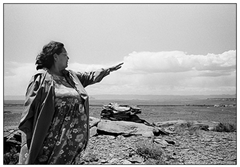
Sarah Jane White looks out over the proposed 600 acre site for the location of the new Desert Rock coal burning power plant. (Photo: © Carlan Tapp)
MACK: Stephen Begay manages the Navajo Power Authority and that’s a question he thinks he can answer.
BEGAY: I think all of Navajo country is sacred land; it’s how we use the resources for the benefit of the good of the whole, you know, for the common. It’s a national effort. We have the Navajo Nation Council approval, 6 to 6, to 7.
MACK: And as for taking care of mother earth? Begay says that’s why they chose to team up with energy developer Sithe Global to build the plant. Dirk Straussfeld is the company’s Executive Vice President:
DIRK: They contacted us because of the environmental performance that we can bring with Desert Rock – low emissions and low water consumption with the lowest emission levels ever being proposed in the U.S.
MACK: It's true Desert Rock would probably be the cleanest conventional coal plant in the country, contributing less than 10% of the area's power plant pollution, despite it's size. Part of the reason this plant looks so good, is because its neighboring plants are so comparatively bad, blanketing the region in haze.
[SOUNDS OF THE CAMP]
MACK: But after so many past problems with coal and uranium, elders like Lucy Willie don’t trust industry claims.
WILLIE: I don’t believe it, not a bit of it. How could they do that? How could they make it like that? When you build the fire, it always come up with that smoke.
MACK: The elders have already weathered one big winter snowstorm so far and Willie says she can handle plenty more.
WILLIE: I can stay here all I want.
MACK: You’ll stay here as long as it takes?
WILLIE: Yeah, that’s what I already said in the beginning. I don’t care and I can stay here all winter until everything is straightened up until they stop and completely stop and then I can go back, otherwise, I’m gonna stay here.
MACK: For its part, Sithe Global Power hopes to break ground later this year and begin producing power in 2011.
For Living on Earth, I’m Eric Mack near Burnham, New Mexico.
Related links:
- Desert Rock Energy Project
- Desert Rock Blog (Opposing the proposed plant)
- Navajo Nation (Supporting the proposed plant)
- Dine C.A.R.E. (Dine Citizens Against Ruining our Environment)
- Photographer Carlan Tapp’s Question of Power project
MUSIC: Nawang Khechog &R. Carlos Nakai “Barbarians at the Gate” from ‘In A Distance Place’ (Canyon Records – 2000)]
GELLERMAN: Coming up: In this year’s Miss America pageant—will climate change get the crown? Keep listening to Living on Earth.
Since you enjoy listening to Living on Earth, chances are you have some pretty good ideas about things that the program should cover. Good news, bad news, or just plain interesting stuff--if you think it would make a worthwhile story for the radio, please get in touch. You can zap us an email at comments @ l-o-e dot org. Or call the Living on Earth listener line, at 800-218-9988. That’s 800-218-99-88. Or write 20 Holland Street, Somerville, Massachusetts 02144.You’re listening to Living on Earth on PRI, Public Radio International.
[MUSIC: GuitarBot (composed by Joshua Fried & Eric Singer) “Emergency Bot TV Theme” from ‘LEMUR: League of Electronic Musical Urban Robots’ (LEMUR - 2006)]
Miss R.I. Heats Up Competition
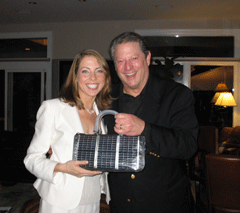
Allison Rogers and Al Gore do some heavy lifting with a Solarjo Solar Power Purse that will charge a cell phone or iPod. Allison participated in the first Climate Project Training Session run by Former Vice President Gore this past September in Nashville.(Courtesy of TheClimateProject.org)
GELLERMAN: It’s Living on Earth. I’m Bruce Gellerman. This year, Allison Rogers will be one of 52 women competing in the Miss America competition.
[MUSIC: “There she is Miss America…”]
[MUSIC: Jon Nakamatsu “Fantasy Impromptu for Piano in C Sharp Minor, Op. 66, CT 46” from ‘Chopin: Impromptus - Fantasies’ (Harmonia Mundi – 1998)]
GELLERMAN: Miss America will be crowned on January 29th in Las Vegas, Nevada.
And if she wins, Allison will be the first contestant from Rhode Island to wear the tiara. Allison Rogers is a graduate of Harvard University. Along with the evening gown and bathing suit competition, she’ll play Chopin’s “Fantasy Impromptu” in the talent segment. And when it comes to her platform statement, she has a unique message. Allison Rogers joins me in the studio, thank you very much for coming in.
ROGERS: Thank you Bruce. It’s wonderful to be here with you.
GELLERMAN: Can I call you Alison?
ROGERS: Oh yeah, please call me Ali. Most people call me Ali.
GELLERMAN: Ok, Ali. What would compel a Harvard Cum Laude graduate to compete in a beauty contest?
ROGERS: I wanted to compete because I wanted to find an alternative way to get the message out about global warming. And I thought that this would certainly be a new audience that I could reach out to through the competition.
GELLERMAN: At Harvard you were something of, well you were more than something of an environmentalist, you were really involved in environmental issues.
ROGERS: I was very involved. You would find me digging through trash, running a waste audit. You would find me running up and down the halls of my dorm encouraging my peers to recycle and to turn off their lights. I became very involved in what we call the resource efficiency program. And after that year of really becoming involved I blossomed in so many ways.
GELLERMAN: You won the Miss. Rhode Island competition last spring. Actually you won it on Earth Day.

The Crowning moment: Allison Rogers was crowned Miss Rhode Island 2006 on April 22 -- Earth Day! (Courtesy of Allison Rogers)
GELLERMAN: So what kind of things do you have to do? Do you have to show up at like PTA meetings?
ROGERS: (laughs) There are the things that you would imagine like parades and at the parades that I’ve been going to I’ve been walking. Which is surprising obviously, most of the time state titleholders will ride in a convertible.
GELLERMAN: Right, with your back sitting out.
ROGERS: Exactly. Until I can find a biodiesel convertible I’ve decided to walk, just in support of my go green platform. And I also do a lot of school presentations; reaching out to students in our community, meetings with politicians, or with businesses. I’ve presented several times at Raytheon about how to green a large institution.
GELLERMAN: We have a bit of tape from one of your presentations, from I guess it’s from Park View Middle School in Cranston Rhode Island. Let’s listen to that.
(GROUPS OF CHILDREN TALKING)
ROGERS: (to the students) So let’s start of with global warming. And first, really quickly, I just want to list out a couple of thoughts about what we can do to help stop global warming. Who wants to share it with me? Do you want to come right up? Yup.
BOY: Um try um to like more car pool so we don’t waste as much pollution.
ROGERS: Yeah, great great. So car pool, or take the bus. Great.
GIRL: Um, more hydroelectric or solar power.
ROGERS: Yes! And what do we call that type of energy? Hydroelectric or solar power do you know what we call that?
GIRL: Renewable energy.
ROGERS: Renewable energy (laughs)!
GELLERMAN: Is it hard talking to kids. It seems, I think you have a real easy time with it.
ROGERS: I love it. And you know at different schools, different classrooms, I get different reactions when I ask them what do they know about global warming. What comes into their mind? But by the end of the presentation it’s obvious that they actually already know a lot before I even started this conversation.
GELLERMAN: Did any kid ever ask you a question you couldn’t answer?
ROGERS: (laughs) I’m going to have to think about that. I will tell you though a fourth grade boy came up to me at the end of one presentation and he said, “Miss. Rhode Island what’s your favorite car? Is it a Lamborghini? And hopefully by the end of our discussion he’s now as excited about hybrid cars as he is for Lamborghinis. (laughs)
GELLERMAN: But Ali, why use the Miss America competition as a venue, as a way of getting this message out?

Allison Rogers and Al Gore do some heavy lifting with a Solarjo Solar Power Purse that will charge a cell phone or iPod. Allison participated in the first Climate Project Training Session run by Former Vice President Gore this past September in Nashville.(Courtesy of TheClimateProject.org
GELLERMAN: But you know, you’ve got to wear a bikini right?
ROGERS: You do have to wear a bikini.
GELLERMAN: You have to wear a gown, bikinis? Global warming?
ROGERS: Well, I will tell you. This is something that I thought about. I went back to my feminist theory and readings and I debated, for a while. I mean, do I want to compete in this? Am I raising my right hand values of environmentalism? Am I lowering my feminist equality values? But I came to a place where I could balance them and thought this was the right thing for me to do.
GELLERMAN: So, if you’re in the top ten, top 15 you get to present your platform. How long do you get?
ROGERS: They normally ask an on stage question, 30 second response. And whether or not it’s a question that you can fit your platform into, we’ll see.
GELLERMAN: Well, you’ve given me the opportunity to play Bert Parks here. So, I’m going to ask you: in 30 seconds give me your platform on global warming.
ROGERS: In 30 seconds, alright. (laughs) I believe that global warming is the most important issue facing us as a country, as a planet, and as humankind. We need to find alternative renewable energies that we can use. We need to find alternative positive habits that we can take in our daily lifestyles. And as your next Miss America, I am ready and willing to take on this full year job of finding a way to change the country, change our planet, and help us have a positive future for our children, our children’s children and the many generations to come.
GELLERMAN: Ali, you have my vote.
ROGERS: (laughs) Thank you.
GELLERMAN: Well, Ali I really enjoyed it. Thank you very much.
ROGERS: Thank you Bruce, this has been wonderful.
GELLERMAN: Allison Rogers is going to compete in this year’s Miss America competition.
Related links:
- Miss Rhode Island website
- Global Youth Climate Movement
- “Miss R.I. warms to her environmental message” in The Providence Journal
[MUSIC: Jon Nakamatsu “Fantasy Impromptu for Piano in C Sharp Minor, Op. 66, CT 46” from ‘Chopin: Impromptus - Fantasies’ (Harmonia Mundi – 1998]
[MUSIC: Bent Bolt and The Nuts “The Mechanical Man” from ‘The Mechanical Man – 7” Single’ (MGM – 1966)]
The Future of Robotics
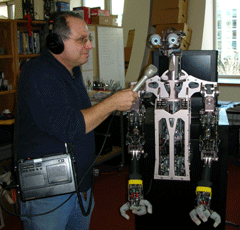
Bruce Gellerman chats up Domo. (Photo: Emily Taylor)
GELLERMAN: Increasingly, living on earth means living with robots; sharing the planet with ever more intelligent machines that perform tasks from the mundane like the robo lawn mower that cuts your grass, to the highly specialized like robo-docs that do surgery. The word robot comes from the Slavic word “rabota,” or work and was first used by Czech science fiction writer Caral Chepeck in 1921. Ever since, robots have stirred and captured our imaginations.
[FAMOUS ROBOT MOVIE MONTAGE FEATURING: “Robbie The Robot” from ‘Forbidden Planet (MGM - 1956),
“HAL 9000” from ‘2001: A Space Odyssey (MGM - 1968),
“Robot” from ‘Lost in Space: The Movie (New Line - 1998),
“C-3P0” and “R2-D2” from ‘Star Wars: Episode IV - A New Hope (LucasFilm - 1977),
Rodney Brooks sound clip from ‘Fast, Cheap & Out of Control’ a film by Errol Morris (Sony Pictures - 1997)]
GELLERMAN: Robosapiens, life-like robots that obey our every command are still the stuff of Hollywood. But at the just concluded consumer electronics show in Las Vegas, robots for the home were being hailed as the next big thing. It’s an industry poised to amaze.
[ROBOT SOUNDS]
To see first hand where things are headed check out MIT’s humanoid robotics group. Here on the Cambridge, Massachusetts campus, grad student Aaron Edsinger has just put the finishing touches on one of the world’s most advanced robots.
EDSINGER: This is my PhD work. This is a, a humanoid robot named Domo.
GELLERMAN: Domo means…?
EDSINGER: Domo means thanks in Japanese but it’s also the name of a song, Domo Arigato, Mr. Roboto.
GELLERMAN: Domo looks a lot like a human. It’s got eyeballs and it’s looking at me. And it’s got this arm with biceps, triceps. I mean put a skin over it and…

Bruce Gellerman chats up Domo.
(Photo: Emily Taylor)
GELLERMAN: Is it perceiving me?
EDSINGER: It can. At the moment the visual cortex is sort of switched off. But when everything is running it can see you, it can interact with you, reach to you, respond to your physical contact. What you see here is that I can grab the arm and it can sense that and it can respond to it when I push on it. So, it’s actually sensing a person’s interaction with it. And the idea is that it’s sort of a partner robot. It works with you to do something, a manual task.
GELLERMAN: Well it’s missing an important part. It’s got no legs.
EDSINGER: No legs, yeah. Legs, legs are hard. We don’t focus on the mobility so much although I think that’s the next obvious step.
GELLEMRNA: That would be major Domo.
EDSINGER: Major Domo, yes.
GELLERMAN: So, what’s the computing power of this?
EDSINGER: This is actually about 15 computers that go into running the robot when everything is turned on. Now most of that is for computer vision. Motor control actually doesn’t take a whole lot of computation.
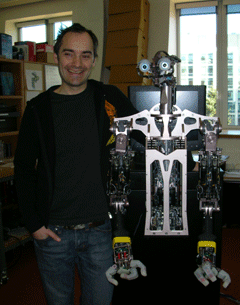
Aaron Edsinger with his robot Domo. (Photo: Emily Taylor)
GELLERMAN: When you were working and building this, did you ever think it was, well another person? Did you ever react to it and start asking it things and expecting things?
EDSINGER: Sure, yeah. You know that it’s a piece of metal and motors. And you know all the code that’s going on behind it but every now and then it acts in a way that you don’t expect. At a certain level it’s hard to know what’s going to happen to it, how it’s going to respond because its behavior is not scripted. It’s really responding to its environment and reacting to that. So sometimes you get that glimpse of it being very life-like.
GELLERMAN: Well, thank you very much congratulations.
[MUSIC: Styx “Mr. Roboto” from ‘Kilroy Was Here’ (A&M – 1983)]
GELLERMAN: Grad student Aaron Edsinger built Domo at MIT’s computer science and artificial intelligence laboratory. The lab’s director is Rodney Brooks. He’s also chief technology officer of Irobot, a company that produces robotic vacuum cleaners. You might have seen Brooks in the movie Fast Cheap and Out of Control playing himself, an eccentric designer of robots.
MOVIE: When I switched the things on the lights flashed and the machine came to life. It moved! Some people believe that we are going to replace ourselves by building these machines and that may be.
GELLERMAN: Rodney Brooks’ office in a space-age building at MIT is a study in controlled chaos. We sit on a couch opposite a wall with a poster of Fast Cheap and Out of Control, and a photo of Brooks and a robot playing with a slinky.
BROOKS: Yeah, that was a robot named Cog, a humanoid form but no legs. And we were really interested, and still are, in robots with arms that are safe to be in the same space as whereas a robot in a factory with arms, you don’t want to be near. So, trying to make robots that are safe to interact with so that ultimately we can have robots manipulating things in the world, doing stuff with us, partnering with us. And for us Baby Boomers, this is going to be important for us in our old age.
GELLERMAN: Oh really, why?
BROOKS: Well, if you look at the demographics of the world there’s going to be many many more elderly compared to working age people, same problem with our social security financing. And where are we going to get all the people to help us in our homes and in our hospitals, we’re going to have to have more robotics help and assistance.
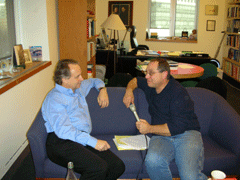
Bruce Gellerman (right) and CSAIL Director Rodney Brooks discuss the future of robotics. (Photo: Emily Taylor)
BROOKS: Well, we’re not there yet, but I think we’re making good progress towards it. You know, we’re starting to see robots in people’s homes. Now, by the standards of 30 years from now those robots are fairly simple. The home cleaning robots, my company Irobot happens to be the biggest manufacturer of them.
GELLERMAN: You’re making, basically vacuum cleaners.
BROOKS: Yeah but they’re robotic vacuum cleaners. You press the clean button and you walk away and they clean the house.
[SOUND OF ROBOTIC VACUUM CLEANER]
GELLERMAN: That thing really works!
BROOKS: Yeah, of course it works! (laughs)
GELLERMAN: But I’m thinking, you know, the Jetsons, where they have Rosie the robot.
BROOKS: Well, we’re not going to have Rosie any time soon. But you gotta think, what were computers like 30 years ago? What are computers like now?
GELLERMAN: Well, we’re in the William H. Gates building at MIT. And Bill Gates has an article in the January issue Scientific America in which he talks about the future of robots. And he says they’re going to be as ubiquitous as computers.
BROOKS: Yeah, he makes the analogy between robots today and computers when Microsoft got started and his company was one of the leading forces in changing what computers could do.
GELLERMAN: So, what do we need to accomplish between where we are now with your vacuum cleaner robot and robots that kind of have arms that swing and paint and where are we going to be in 10 years?
BROOKS: Well, I say that there’s 2 really critical things that we as researchers should be working on at the universities. We need the visual object recognition capabilities of a two-year-old child and the manual dexterity of a 6-year-old child. They are the 2 capabilities that I think are important to go after in the research demand right now. We’re making progress on both of them although both have a long history of not necessarily great success over the years.
GELLERMAN: People think about robots, I think they think about humanoid robots, that is things that look like us that we create in our own images. When you think robot is that what you’re thinking of?
BROOKS: I could believe either way. It could be that we want robots with our own form or we could have robots with other forms. But we will want to be able to interact with them socially. Let me tell you what I mean by that. We interact with our dogs socially. We know what our dog is looking at, what the dog is paying attention to. Our dogs know what our gaze direction is. They understand us. We understand them. I think we’re going to need that intuitive understanding of what our robots are trying to do. And our robots are going to need the intuitive understanding of what it is we’re trying to do and then co-exist with us and help us. And if they don’t do that, no ones going to buy it.
GELLERMAN: When we design these robots it seems like we design them in our own image. And that when we try to give them intelligence and maybe even consciousness that it’s really not saying what is a robot. We’re asking the question what is human?
BROOKS: Well, that’s I think one of the biggest drivers for us in my research lab here has been what is human and trying to understand that by building models. For me the most remarkable thing has been how simple the social interaction parts are to build. Now what’s hard is object recognition, manipulation, the stuff that two-year-olds can do.
GELLERMAN: So, now look out 100 years. I know it’s the stuff of science fiction. Are we going to have robot people?
BROOKS: Well, we don’t have robot birds yet. We’ve got really good machines that fly but we don’t have machines that fly like birds. So, I think that we get the essence, but whether we go to the trouble of making it identical to a human, I don’t know. Now could it be 100 years from now that we have robots that are truly intelligent and true beings? In principle, absolutely. You know, I as a sort of strong scientist think that we are machines. You and I are machines. We’re made of biomolecules. Biomolecules interact through the laws of chemistry and physics. So we are machines. So in principle it seems that we should be able to have machines built out of other stuff, which are intelligent like us. Now another question is, are we humans smart enough to build such machines? That’s an open question. You know, you look at a raccoon. A raccoon is very dextrose with its hands. You know it can unlock things and get into places and stuff. But I don’t know any one who’s looked at a raccoon and thought, hey one day that raccoon is going to build a robot raccoon just like itself.
GELLERMAN: (laughing)
BROOKS: So you can imagine the guys from Alpha Centauri, from another solar system, are up in their UFOs they’re looking down, and they’re looking at MIT and they say, “Oh look at those little professors there. They’re going to build robot versions of themselves. Aren’t they cute!
GELLERMAN: It seems that this is as much philosophy as physics.
BROOKS: It’s a mixture of the two. And therefore it’s very murky. And therefore many scientists feel very uncomfortable about it.
GELLERMAN: How do you feel about it?
BROOKS: I feel fascinated. What could be more fun, except going to space?
GELLERMAN: Dr. Brooks, I want to thank you very much.
BROOKS: Thank you.
Related links:
- MIT’s Computer Science and Artificial Intelligence Laboratory
- Aaron Edsinger-Gonzales’s website
- “A Robot in Every Home” by Bill Gates in Scientific American
- Rodney Brooks’ iRobot Corp.
- Consumer Electronics Show website
[MUSIC: Kraftwerk “The Robots” from ‘The Mix’ (Elektra Entertainment – 1991)]
GELLERMAN: Rodney Brooks is director of MIT’s Computer Science and Artificial Intelligence Laboratory and chief technology officer of Irobot. For photos of him and Aaron Edsinger’s robosapien Domo log on to our website loe dot org.
[MUSIC: Kraftwerk “The Robots” from ‘The Mix’ (Elektra Entertainment – 1991)]
GELLERMAN: Next week on Living on Earth. The 2008 Presidential campaign is heating up, but then again for Al Gore, so is the planet.
GORE: I've fallen out of love with politics. I'm not hungering to ever be a candidate again and really do not anticipate any circumstances in which I would be. But, I'm involved in a different kind of campaign.
GELLERMAN: Al Gore takes his climate change show on the road and we go along next time on Living on Earth.
[MUSIC: Kraftwerk “The Robots” from ‘The Mix’ (Elektra Entertainment – 1991)]
Living on Earth is produced by the World Media Foundation. Our crew includes Ashley Ahearn, Eileen Bolinsky, Ian Gray, Ingrid Lobet, Emily Taylor, Peter Thomson and Jeff Young - with help from Bobby Bascomb, and Kelley Cronin. Our interns are Paige Doughty and Meghan Vigeant. Dennis Foley is our technical director. Our executive producer is Steve Curwood. Alison Lirish Dean composed our themes. You can find us at loe dot org. I’m Bruce Gellerman. Thanks for listening.
ANNOUNCER: Funding for Living on Earth comes from the National Science Foundation, supporting coverage of emerging science; And Stonyfield Farm; Organic yogurt and smoothies. Stonyfield pays its farmers not to use artificial growth hormones on their cows. Details at Stonyfield dot com.
Support also comes from you our listeners, the Ford Foundation, the Town Creek Foundation, and the Saunders Hotel Group of Boston's Lennox and Copley Square Hotels. Serving you and the environment while helping preserve the past and protect the future, 800-225-7676.
Living on Earth wants to hear from you!
Living on Earth
62 Calef Highway, Suite 212
Lee, NH 03861
Telephone: 617-287-4121
E-mail: comments@loe.org
Newsletter [Click here]
Donate to Living on Earth!
Living on Earth is an independent media program and relies entirely on contributions from listeners and institutions supporting public service. Please donate now to preserve an independent environmental voice.
NewsletterLiving on Earth offers a weekly delivery of the show's rundown to your mailbox. Sign up for our newsletter today!
 Sailors For The Sea: Be the change you want to sea.
Sailors For The Sea: Be the change you want to sea.
 The Grantham Foundation for the Protection of the Environment: Committed to protecting and improving the health of the global environment.
The Grantham Foundation for the Protection of the Environment: Committed to protecting and improving the health of the global environment.
 Contribute to Living on Earth and receive, as our gift to you, an archival print of one of Mark Seth Lender's extraordinary wildlife photographs. Follow the link to see Mark's current collection of photographs.
Contribute to Living on Earth and receive, as our gift to you, an archival print of one of Mark Seth Lender's extraordinary wildlife photographs. Follow the link to see Mark's current collection of photographs.
 Buy a signed copy of Mark Seth Lender's book Smeagull the Seagull & support Living on Earth
Buy a signed copy of Mark Seth Lender's book Smeagull the Seagull & support Living on Earth

